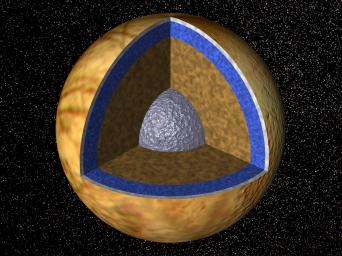
|
Interior of Europa
- Click the image above for a larger view
- Full-Res JPEG (2666 x 2000) (540.9 kB)
- Full-Res TIFF (2666 x 2000) (9.0 MB)
Caption:
Cutaway view of the possible internal structure of Europa The surface of the satellite is a mosaic of images obtained in 1979 by NASA's Voyager spacecraft. The interior characteristics are inferred from gravity field and magnetic field measurements by NASA's Galileo spacecraft. Europa's radius is 1565 km, not too much smaller than our Moon's radius. Europa has a metallic (iron, nickel) core (shown in gray) drawn to the correct relative size. The core is surrounded by a rock shell (shown in brown). The rock layer of Europa (drawn to correct relative scale) is in turn surrounded by a shell of water in ice or liquid form (shown in blue and white and drawn to the correct relative scale). The surface layer of Europa is shown as white to indicate that it may differ from the underlying layers. Galileo images of Europa suggest that a liquid water ocean might now underlie a surface ice layer several to ten kilometers thick. However, this evidence is also consistent with the existence of a liquid water ocean in the past. It is not certain if there is a liquid water ocean on Europa at present.
Background Info:
The Jet Propulsion Laboratory, Pasadena, CA manages the mission for NASA's Office of Space Science, Washington, DC.
This image and other images and data received from Galileo are posted on the World Wide Web, on the Galileo mission home page at URL http://www.jpl.nasa.gov/galileo/sepo .
Cataloging Keywords:
| Name | Value | Additional Values |
|---|---|---|
| Target | Europa | |
| System | Jupiter | |
| Target Type | Satellite | |
| Mission | Galileo | Voyager |
| Instrument Host | Galileo Orbiter | |
| Host Type | Orbiter | Flyby Spacecraft |
| Instrument | Solid-State Imaging (SSI) | |
| Detector | ||
| Extra Keywords | Color, Magnetosphere, Moon, Water | |
| Acquisition Date | ||
| Release Date | 1997-12-18 | |
| Date in Caption | ||
| Image Credit | NASA/JPL | |
| Source | photojournal.jpl.nasa.gov/catalog/PIA01130 | |
| Identifier | PIA01130 | |
